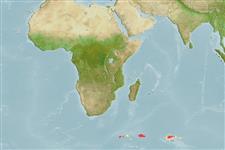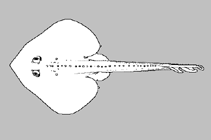Add your observation in Fish Watcher
| Native range | All suitable habitat | Point map | Year 2050 |

|
| This map was computer-generated and has not yet been reviewed. |
| Amblyraja taaf AquaMaps Data sources: GBIF OBIS |
Upload your photos and videos
Google imageNo image available for this species;
drawing shows typical species in Rajidae.
Google imageNo image available for this species;
drawing shows typical species in Rajidae.
Classification / Names Nombres comunes | Sinónimos | Catalog of Fishes(Género, Especie) | ITIS | CoL | WoRMS | Cloffa
Elasmobranquios (tiburones y rayas) (sharks and rays) > Rajiformes (Skates and rays) > Rajidae (Skates)
Etymology: Amblyraja: Greek, amblys = darkness + Latin, raja, -ae = ray (Raja sp.) (Ref. 45335).
Eponymy: This is a form of toponym rather than an eponym: TAAF = Territoire des Terres australes et antarctiques françaises (French Southern and Antarctic Territories). (Ref. 128868), visit book page.
Etymology: Amblyraja: Greek, amblys = darkness + Latin, raja, -ae = ray (Raja sp.) (Ref. 45335).
Eponymy: This is a form of toponym rather than an eponym: TAAF = Territoire des Terres australes et antarctiques françaises (French Southern and Antarctic Territories). (Ref. 128868), visit book page.
Issue
Possibly a junior synonym of A. hyperborea due to strong morphological similarity according to Ebert & Stehmann (2013, Ref. 98315) and Weigmann (2016, Ref. 118749) (Ref. 118749).
Environment: milieu / climate zone / depth range / distribution range Ecología
marino batidemersal; rango de profundidad 150 - 600 m (Ref. 114953), usually 375 - 390 m (Ref. 58018). Polar; 35°S - 49°S, 180°W - 180°E
Distribución Países | Áreas FAO | Ecosistemas | Ocurrencias, apariciones | Point map | Introducciones | Faunafri
Southeastern Atlantic: South Africa (Compagno et al. in Ebert et al. 2009 but see Ref. 114953); Indian Ocean: Crozet I. (Ref. 45488). Subantarctic: Widespread.
Tamaño / Peso / Age
Found on insular shelves and slopes. Mainly feeds on benthic invertebrates and bony fishes (Ref. 114953). Oviparous (Ref. 50449). Eggs have horn-like projections on the shell (Ref. 205). Young hatches at ca. 17 cm TL (Ref. 114953).
Life cycle and mating behavior Madurez | Reproducción | Puesta | Huevos | Fecundidad | Larva
Oviparous, paired eggs are laid. Embryos feed solely on yolk (Ref. 50449). Eggs have horn-like projections on the shell (Ref. 205).
Main reference
Upload your references | Referencias | Coordinador : McEachran, John | Colaboradores
McEachran, J.D. and K.A. Dunn, 1998. Phylogenetic analysis of skates, a morphologically conservative clade of elasmobranchs (Chondrichthyes: Rajidae). Copeia 1998(2):271-290. (Ref. 27314)
IUCN Red List Status (Ref. 130435: Version 2024-2)
Data deficient (DD) ; Date assessed: 01 August 2019
CITES
Not Evaluated
Threat to humans
Harmless
Human uses
Pesquerías: pesquerías de subsistencia
FAO - Publication: search | FishSource | Sea Around Us
Más información
Trophic ecology
componentes alimenticios
Composición de la dieta
consumo de alimento
Food rations
Despredadores
componentes alimenticios
Composición de la dieta
consumo de alimento
Food rations
Despredadores
Ecology
Ecología
Ecología
Population dynamics
Coeficiente del crecimiento para
Max. ages / sizes
Length-weight rel.
Length-length rel.
Length-frequencies
Mass conversion
Reclutamiento
Abundancia
Coeficiente del crecimiento para
Max. ages / sizes
Length-weight rel.
Length-length rel.
Length-frequencies
Mass conversion
Reclutamiento
Abundancia
Life cycle
Reproducción
Madurez
Maturity/Gills rel.
Fecundidad
Puesta
Spawning aggregations
Huevos
Egg development
Larva
Dinámica larvaria
Reproducción
Madurez
Maturity/Gills rel.
Fecundidad
Puesta
Spawning aggregations
Huevos
Egg development
Larva
Dinámica larvaria
Anatomy
Superficie branquial
Brain
Otolith
Superficie branquial
Brain
Otolith
Physiology
Body composition
Nutrients
Consumo del oxígeno
Tipo de natación
Velocidad de natación
Visual pigments
Fish sound
Diseases & Parasites
Toxicity (LC50s)
Body composition
Nutrients
Consumo del oxígeno
Tipo de natación
Velocidad de natación
Visual pigments
Fish sound
Diseases & Parasites
Toxicity (LC50s)
Genetics
Genética
Heterozygosity
heritabilidad
Genética
Heterozygosity
heritabilidad
Human related
Aquaculture systems
Perfiles de acuicultura
Razas
Ciguatera cases
Stamps, coins, misc.
Aquaculture systems
Perfiles de acuicultura
Razas
Ciguatera cases
Stamps, coins, misc.
Herramientas
E-book | Guía de campo | Asistente para frecuencias de tallas | Herramienta de ciclo de vida | Mapa de puntos | Classification Tree
| Catch-MSY |
Special reports
Download XML
Fuentes de Internet
AFORO (otoliths) | Aquatic Commons | BHL | Cloffa | BOLDSystems | Websites from users | Check FishWatcher | CISTI | Catalog of Fishes: Género, Especie | DiscoverLife | ECOTOX | FAO - Publication: search | Faunafri | Fishipedia | Fishtrace | GenBank: genome, nucleotide | GloBI | Google Books | Google Scholar | Google | IGFA World Record | MitoFish | Otolith Atlas of Taiwan Fishes | PubMed | Reef Life Survey | Socotra Atlas | Árbol de la vida | Wikipedia: Go, búsqueda | World Records Freshwater Fishing | Expediente Zoológico
Estimates based on models
Preferred temperature (Ref. 123201): 1.4 - 2.3, mean 2 °C (based on 27 cells).
Phylogenetic diversity index (Ref. 82804): PD50 = 0.5010 [Uniqueness, from 0.5 = low to 2.0 = high].
Bayesian length-weight: a=0.00302 (0.00141 - 0.00645), b=3.24 (3.07 - 3.41), in cm total length, based on LWR estimates for this (Sub)family-body shape (Ref. 93245).
Nivel trófico (Ref. 69278): 4.2 ±0.3 se; based on size and trophs of closest relatives
Resiliencia (Ref. 120179): Bajo, población duplicada en un tiempo mínimo de 4.5-14 años (Fec assumed to be <100).
Fishing Vulnerability (Ref. 59153): High vulnerability (56 of 100).
Climate Vulnerability (Ref. 125649): Very high vulnerability (100 of 100).




